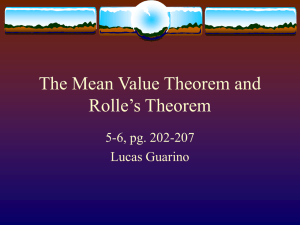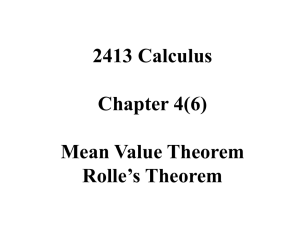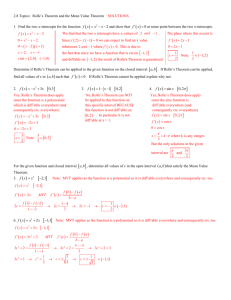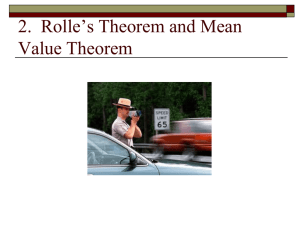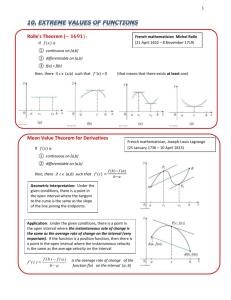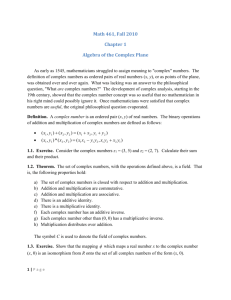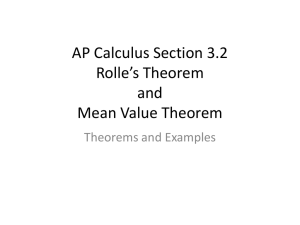Rolles Theorem
advertisement
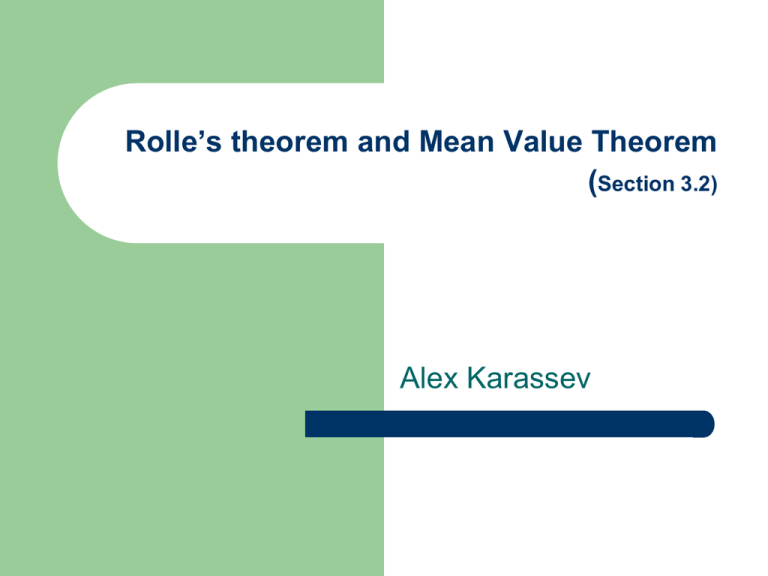
Rolle’s theorem and Mean Value Theorem (Section 3.2) Alex Karassev Rolle’s Theorem y y f ′ (c) = 0 y = f(x) y = f(x) f(a) = f(b) x a Example 1 c b x a c1 Example 2 c2 c3 b Rolles Theorem Suppose f is a function such that y f ′ (c) = 0 f is continuous on [a,b] differentiable at least in (a,b) If f(a) = f(b) then there exists at least one c in (a,b) such that f′(c) = 0 y = f(x) x a c b Applications of Rolle’s Theorem It is used in the prove of the Mean Value Theorem Together with the Intermediate Value Theorem, it helps to determine exact number of roots of an equation Example Prove that the equation cos x = 2x has exactly one solution y = 2x y = cos x Solution cos x = 2x has exactly one solution means two things: It has a solution – can be proved using the IVT It has no more than one solution – can be proved using Rolle's theorem cos x = 2x has a solution: Proof using the IVT cos x = 2x is equivalent to cos x – 2x = 0 Let f(x) = cos x – 2x f is continuous for all x, so the IVT can be used f(0) = cos 0 – 2∙0 = 1 > 0 f(π/2) = cos π/2 – 2 ∙ π/2 = 0 – π = – π < 0 Thus by the IVT there exists c in [0, π/2] such that f(c) = 0, so the equation has a solution f(x) = cos x – 2x = 0 has no more than one solution: Proof by contradiction using Rolle's theorem Assume the opposite: the equation has at least two solutions Then there exist two numbers a and b s.t. a ≠ b and f(a) = f(b) = 0 In particular, f(a) = f(b) f(x) is differentiable for all x, and hence Rolle's theorem is applicable By Rolle's theorem, there exists c in [a,b] such that f′(c) = 0 Find the derivative: f ′ (x) = (cos x – 2x) ′ = – sin x – 2 So if we had f ′ (c) = 0 it would mean that –sin c – 2 = 0 or sin c = – 2, which is impossible! Thus we obtained a contradiction All our steps were logically correct so the fact that we obtained a contradiction means that our original assumption "the equation has at least two solutions" was wrong Thus, the equation has no more than one solution! f(x) = cos x – 2x = 0 has no more than one solution: visualization If it had two roots, then there would exist a ≠ b such that f(a) = f(b) = 0 f ′ (c) = 0 y = f(x) a c b But f ′ (x) = (cos x – 2x) ′ = – sin x – 2 So if we had f ′ (c) = 0 it would mean that –sin c – 2 = 0 or sin c = – 2, which is impossible Mean Value Theorem y y y = f(x) y = f(x) x x a c Example 1 b b a Example 2 There exists at least one point on the graph at which tangent line is parallel to the secant line Mean Value Theorem f′(c) = f(b) – f(a) (b-a) y y = f(x) f (b ) f ( a ) ba x a c Slope of secant line is the slope of line through the points (a,f(a)) and (b,f(b)), so it is b Slope of tangent line is f′(c) MVT: exact statement f′(c) = f(b) – f(a) (b-a) Suppose f is continuous on [a,b] and differentiable on (a,b) Then there exists at least one point c in (a,b) such that y y = f(x) x a c b f (b) f (a) f (c) ba MVT: alternative formulations f (b) f (a) f (c) ba f (b) f (a ) f (c)(b a ) f (b) f (a) f (c)(b a) Interpretation of the MVT using rate of change Average rate of change f (b ) f ( a ) ba is equal to the instantaneous rate of change f′(c) at some moment c Example: suppose the cities A and B are connected by a straight road and the distance between them is 360 km. You departed from A at 1pm and arrived to B at 5:30pm. Then MVT implies that at some moment your velocity v(t) = s′(t) was: (s(5.5) – s(1)) / (5.5 – 1) = 360 / 4.5 = 80 km / h Application of MVT Estimation of functions Connection between the sign of derivative and behavior of the function: if f ′ > 0 function is increasing if f ′ < 0 function is decreasing Error bounds for Taylor polynomials Example Suppose that f is differentiable for all x If f (5) = 10 and f ′ (x) ≤ 3 for all x, how small can f(-1) be? Solution MVT: f(b) – f(a) = f ′(c) (b – a) for some c in (a,b) Applying MVT to the interval [ –1, 5], we get: f(5) – f(–1) = f ′(c) (5 – (– 1)) = 6 f ′(c) ≤ 6∙3 = 18 Thus f(5) – f(-1) ≤ 18 Therefore f(-1) ≥ f(5) – 18 = 10 – 18 = – 8

